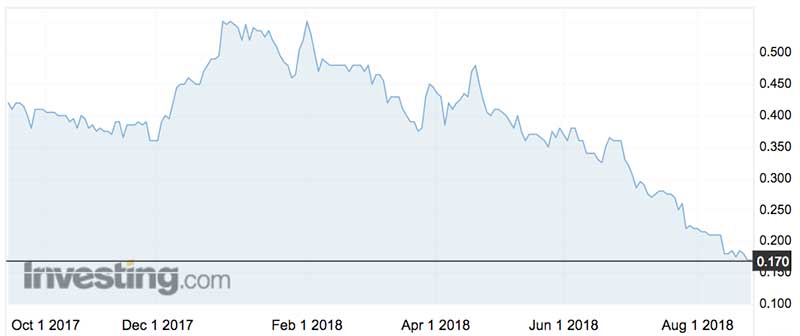What’s next for lens maker Visioneering after $12m capital raising
Health & Biotech
Health & Biotech
Multifocal contact lenses have a shortcoming that even Blind Freddy can see.
Yet it took some visionary work from Atlanta-based Visioneering Technologies to rectify the problem.
You see, your typical multifocal contacts have three concentric zones – near, distance and intermediate – but it’s virtually impossible to provide seamless clarity across these zones.
Visioneering (ASX:VTI) went back to the future and deployed the principles of a pin-hole camera, which has an infinite depth of focus so that near and distant objects can be viewed without blurriness.
The resulting range of Naturalvue contacts addresses two overlooked conditions: childhood myopia (short-sightedness) and age-related presbyopia (long-sightedness or the inability to see near objects and nothing to do with a Protestant religion).
The story to date
Visioneering was incorporated in Delaware (where else?) in 2008, based on the work of a Dr Richard Griffin.
Dr Griffin was an aeronautical engineer who nutted out that a pinhole aperture known for improving depth of field in photography could be applied to make a better contact lens.
We’re not sure about the nexus between aviation and optics, but it’s all science-y.
Dr Griffin and co-mucked about with bench top designs, before a liaison with Taiwanese contact lens maker Pegavision Corp enabled full-scale production.
Two funds, MB Venture Partners and Charter Life Sciences came on as strong pre-initial public offer supporters.
Visioneering listed on the ASX in March 2017 after raising $33 million in an oversubscribed offer at 42c.

Visioneering’s contacts are approved for sale in the US (and are sold there). The company earlier this year also won local and European assent for childhood myopia.
The company estimates the size of the US market at $US3.4 billion for presbyopia and $US2 billion for paediatric myopia.
About the lens
Visioneering’s focal point is that the current multifocal lenses on the market are made of three layers that don’t interact well with each other. This means that there’s always a degree of compromise between the near and distant vision components.
It’s like buying those $10 specs from the chemist on the basis they work well enough — and perhaps they do.
But the pinhole principle means that the Naturalvue lenses are simpler. By inducing a ‘virtual pinhole’, the lenses enable the eye to deliver the brain clear vision of near, intermediate and distant objects, “all without employing complex zones of near and distance powers”.
With a normal multifocal, there are dozens of permutations of lens strength because both the near-distance and long-distance layers vary according to the prescription.
This makes fitting the lens a “frustrating and time-consuming experience” for patient and eye care professional alike.
The Naturalvue lenses are much simpler.

In June, Visioneering released two extension lines: traditional spherical contacts and MF contacts in a greater range of strengths. The company is due to launch lenses for astigmatism in 2018 and for astigmatism with presbyopia, Naturalvue Toric and MF (multifocal) Toric, in the first half of 2019.
Toric lenses have two different curves instead of one and correct both astigmatism and short or long-sightedness. Astigmatism is a defect in the eye which results in distorted images.
Path to market
Visioneering has changed it distribution approach from selling directly to eye care professionals to deploying “fulfilment partners”.
The fulfilment partner (a glorified logistics company) handles shipping, returns and credit risk — anything but selling the product.
By piggybacking on deliveries for other optical providers such as industry leader ABB, Visioneering reduced the cost of sending out a consignment of lenses to opticians from $US15-20 to around $US6.
The other benefit is that practitioners are highly likely to use only one fulfilment provider, so not being in their delivery truck will put accounts off limit.
One Visioneering multifocal lens sells for $US1.05 to $US1.20, bearing in mind that most users have a different prescription for each eye. “They are pitched at the same price as other multi focal lenses,” CEO Dr Stephen Snowdy says.
“We don’t want to give any optometrist a reason not to use us.”
Multifocals are more expensive than standard lenses because of the special design that helps both (myopia and presbyopia) patient populations.
Dr Snowdy says the company didn’t move to the fulfilment model because of poor initial sales.
“It’s just the opposite,” he says. “We were too small when we got started but once sales got bigger they said we would take us on.”
Visioneering also supplies standard spherical (non- multifocal) lenses. “We are paying for the sales reps anyway so might as well throw as much in their bags as possible,” Dr Snowdy says.
Indeed!
Financials and performance
Visioneering’s sales have been gaining traction off a low base, with second (June) quarter revenues increasing by 9 per cent to $US607,202 ($US1.2 million for the first half).
In calendar 2017, the company lost $US17 million on revenue of $US1 million, so the trend is the company’s friend.
Management’s favourite measure is net revenue of goods actually shipped to the eye care professionals by the intermediaries. On this basis, revenue gained 40 per cent to $US683,218.
The company cites 1,149 active accounts, a 22 per cent increase on the quarter.
Dr Snowdy says Visioneering’s sales emphasis is shifting from growing current accounts, rather than deploying more sales staff to sniff out new ones.
The company is targeting $US5,000 to $US12,000 of revenue per mature optician account with peak maturity usually within two to four years.
On our sums, that equates to annual revenue of $US5.7 million to $US13.8 million.
Perhaps routinely, Visioneering’s 2017 accounts said there was substantial doubt about Visioneering continuing as a going concern without raising more moolah.
Lo and behold, in mid-August the company said it had raked in $8.9 million in a private placement to sophisticated and professional investors, at 18c a share.
The company is also undertaking a share purchase plan to raise a further $3 million.
The funds will take Visioneering’s cash balance to $18 million, “which on current expectations provide the working capital to fund our growth for at least the next 12 months”.
Visioneering had accrued $US42 million of losses as of December 2017, so won’t be bugged by the fiscal fiend in the foreseeable future.
Dr Boreham’s diagnosis
A keen licensed pilot, Dr Snowdy took his family up to 11,000 feet in a Mooney four-seater in the Georgian skies, to witness the “zone of totality” in the recent total eclipse.
Similarly, Dr Snowdy says the sky is the limit for Visioneering on market penetration. But we all know how commercial mis-steps (such as inappropriate pricing) can shade such ambitions.
“Things are growing very rapidly and we don’t have to take much of the market to be a very large company,” he says.
Visioneering’s greater fortunes may lie in Asia, for the simple reason that 80 per cent to 90 per cent of the vast populace is inherently short-sighted.
Old timers will recall how the Western powers assumed the Japanese couldn’t wage aerial warfare for this reason — a tragic underestimation.
Wisely, the company will tackle the key markets of Japan and China in partnership with someone who knows the regulatory wiles of these countries.
This column first appeared in Biotech Daily
Disclosure: Dr Boreham is not a qualified medical practitioner and does not possess a doctorate of any sort. But he is a man of vision who doesn’t see the sector entirely through rose-colored glasses.
The content of this article was not selected, modified or otherwise controlled by Stockhead. Stockhead has not provided, endorsed or otherwise assumed responsibility for any financial product advice contained in this article.